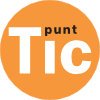The project 'Consolidation of collaborative work in the Jaume Balmes school as an educational tool using 3D printing and editing tools' has been developed thanks to the Digital Social Innovation course promoted by the Secretariat of Digital Policies of the Generalitat of Catalonia and with the collaboration of CoEbreLab, CoboiLab, CitiLab and Sant Feliu Innova. It took place during the second quarter of 2022.
This challenge has been carried out from the SmartLAB of the SmartCentre TIC Point in Santa Bárbara with the town's primary school, with the aim of teaching its students how the 3D printers of the SmartLAB work. The students were able to see first-hand the operation and results of these machines.
the challenge
They immediately found a line of work in a project of the school's Language Department that suited the desired line of work. "Students throughout the school work in the last term on a game creation project and each term creates one and works in the classroom. They work and come up with ideas in the classroom," explains Mercè Fort , facilitator of the ICT point
Thus, the students created the games, their rules, the game board and/or cards, but the tiles and dice were missing to be able to play the games they had worked on in class. "The option of being able to include 3D printers and laser engraving as work tools opened up a whole range of options and a different way of approaching this part of the activity," explains Fort .
the games
Thirty-six P5 students created personalized Goose Game boards. To do the work they were organized into teams. Each team chose the shape of the tiles and drew them on a paper as a first tool for working and designing the prototypes they thought of. Then, in the SmartCentre's computer room, they worked on drawing and 3D design on the computer so they could print the parts. In the case of the dice, they created some adapted to their age, with a larger size and with very clear numbers.
Thirty-one 2nd graders worked on the Checkers game , creating their own boards and adapting the tiles to the size of the game boards. They also drew different designs of what the tiles could look like.
Regarding the 4th grade students , thirty-five participated and the game they worked on was Jenga . They created their own questions for the game and customized them. In the classroom, they worked on how to design polygons in certain sizes.


